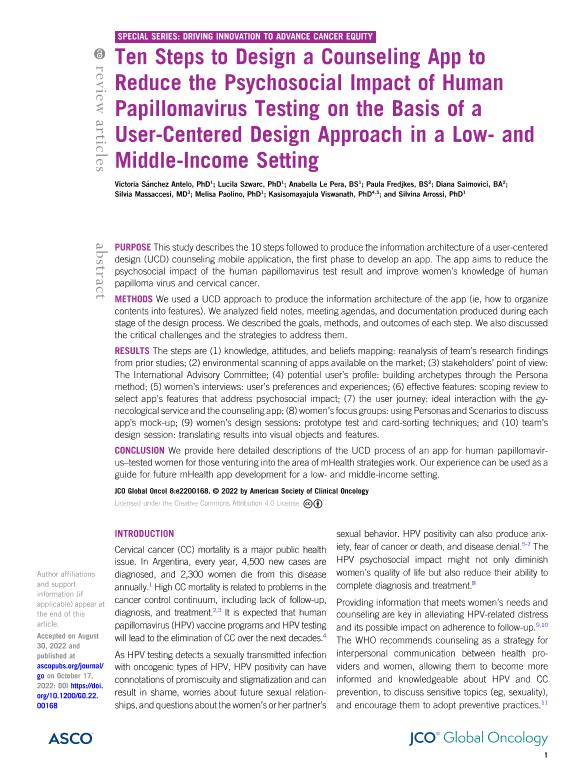Mostrar el registro sencillo del ítem
dc.contributor.author
Sánchez Antelo, Victoria Inés María

dc.contributor.author
Szwarc, Lucila

dc.contributor.author
Le Pera, Anabella Hebe

dc.contributor.author
Fredjkes, Paula
dc.contributor.author
Saimovici, Diana
dc.contributor.author
Massaccesi, Silvia
dc.contributor.author
Paolino, Melisa Delia

dc.contributor.author
Viswanath, Kasisomayajula

dc.contributor.author
Arrossi, Silvina

dc.date.available
2023-11-15T14:37:19Z
dc.date.issued
2022-10
dc.identifier.citation
Sánchez Antelo, Victoria Inés María; Szwarc, Lucila; Le Pera, Anabella Hebe; Fredjkes, Paula; Saimovici, Diana; et al.; Ten Steps to Design a Counseling App to Reduce the Psychosocial Impact of Human Papillomavirus Testing on the Basis of a User-Centered Design Approach in a Low- and Middle-Income Setting; American Society of Clinical Oncology; JCO global oncology; 8; e2200168; 10-2022; 1-14
dc.identifier.uri
http://hdl.handle.net/11336/218164
dc.description.abstract
PURPOSE: This study describes the 10 steps followed to produce the information architecture of a user-centered design (UCD) counseling mobile application, the first phase to develop an app. The app aims to reduce the psychosocial impact of the human papillomavirus test result and improve women's knowledge of human papilloma virus and cervical cancer. METHODS: We used a UCD approach to produce the information architecture of the app (ie, how to organize contents into features). We analyzed field notes, meeting agendas, and documentation produced during each stage of the design process. We described the goals, methods, and outcomes of each step. We also discussed the critical challenges and the strategies to address them. RESULTS: The steps are (1) knowledge, attitudes, and beliefs mapping: reanalysis of team's research findings from prior studies; (2) environmental scanning of apps available on the market; (3) stakeholders' point of view: The International Advisory Committee; (4) potential user's profile: building archetypes through the Persona method; (5) women's interviews: user's preferences and experiences; (6) effective features: scoping review to select app's features that address psychosocial impact; (7) the user journey: ideal interaction with the gynecological service and the counseling app; (8) women's focus groups: using Personas and Scenarios to discuss app's mock-up; (9) women's design sessions: prototype test and card-sorting techniques; and (10) team's design session: translating results into visual objects and features. CONCLUSION: We provide here detailed descriptions of the UCD process of an app for human papillomavirus-tested women for those venturing into the area of mHealth strategies work. Our experience can be used as a guide for future mHealth app development for a low- and middle-income setting.
dc.format
application/pdf
dc.language.iso
eng
dc.publisher
American Society of Clinical Oncology
dc.rights
info:eu-repo/semantics/openAccess
dc.rights.uri
https://creativecommons.org/licenses/by/2.5/ar/
dc.subject
Human Papillomavirus Testing
dc.subject
Psychosocial Impact
dc.subject
Counseling App
dc.subject
information architecture of a user-centered design (UCD)
dc.subject.classification
Políticas y Servicios de Salud

dc.subject.classification
Ciencias de la Salud

dc.subject.classification
CIENCIAS MÉDICAS Y DE LA SALUD

dc.title
Ten Steps to Design a Counseling App to Reduce the Psychosocial Impact of Human Papillomavirus Testing on the Basis of a User-Centered Design Approach in a Low- and Middle-Income Setting
dc.type
info:eu-repo/semantics/article
dc.type
info:ar-repo/semantics/artículo
dc.type
info:eu-repo/semantics/publishedVersion
dc.date.updated
2023-11-14T14:22:22Z
dc.identifier.eissn
2687-8941
dc.journal.number
8; e2200168
dc.journal.pagination
1-14
dc.journal.pais
Estados Unidos

dc.journal.ciudad
Virginia
dc.description.fil
Fil: Sánchez Antelo, Victoria Inés María. Centro de Estudios de Estado y Sociedad; Argentina. Consejo Nacional de Investigaciones Científicas y Técnicas; Argentina
dc.description.fil
Fil: Szwarc, Lucila. Consejo Nacional de Investigaciones Científicas y Técnicas; Argentina. Centro de Estudios de Estado y Sociedad; Argentina
dc.description.fil
Fil: Le Pera, Anabella Hebe. Consejo Nacional de Investigaciones Científicas y Técnicas; Argentina. Centro de Estudios de Estado y Sociedad; Argentina
dc.description.fil
Fil: Fredjkes, Paula. Centro de Estudios de Estado y Sociedad; Argentina
dc.description.fil
Fil: Saimovici, Diana. Centro de Estudios de Estado y Sociedad; Argentina
dc.description.fil
Fil: Massaccesi, Silvia. Provincia de Buenos Aires. Ministerio de Salud; Argentina
dc.description.fil
Fil: Paolino, Melisa Delia. Consejo Nacional de Investigaciones Científicas y Técnicas; Argentina. Centro de Estudios de Estado y Sociedad; Argentina
dc.description.fil
Fil: Viswanath, Kasisomayajula. Harvard University. Harvard School of Public Health; Estados Unidos
dc.description.fil
Fil: Arrossi, Silvina. Consejo Nacional de Investigaciones Científicas y Técnicas; Argentina. Centro de Estudios de Estado y Sociedad; Argentina
dc.journal.title
JCO global oncology
dc.relation.alternativeid
info:eu-repo/semantics/altIdentifier/url/https://ascopubs.org/doi/10.1200/GO.22.00168
dc.relation.alternativeid
info:eu-repo/semantics/altIdentifier/doi/http://dx.doi.org/10.1200/GO.22.00168
Archivos asociados
